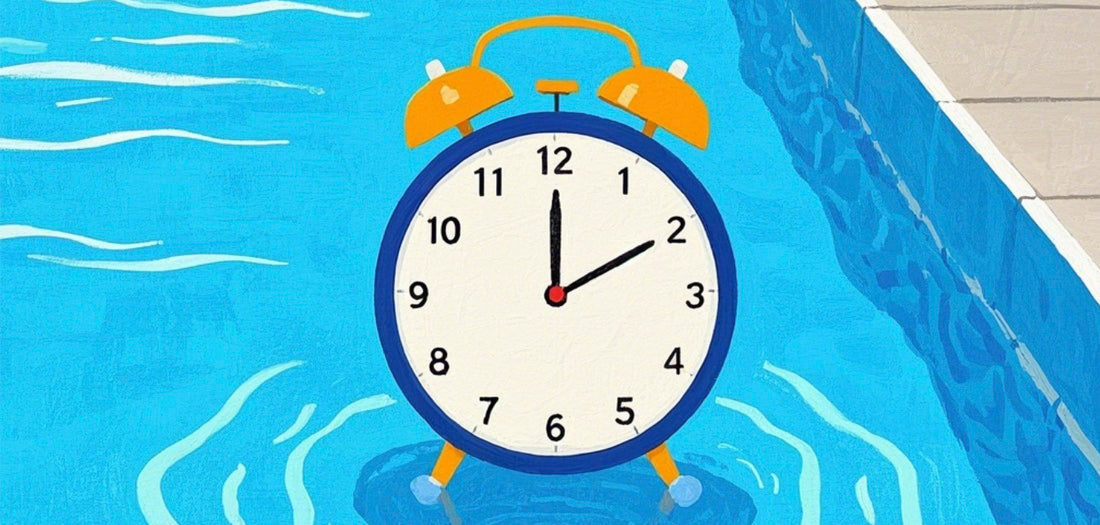
How Long Should You Wait to Swim After Adding Pool Chemicals?
Share
When you add chemicals to your pool, they don’t work instantly. They need time to dissolve and spread evenly, ensuring the water is properly balanced. Swimming too soon can result in overexposure to chemicals, leading to skin and eye irritation, or even an unbalanced pool that requires additional treatment. Chlorine, pH adjusters, and other chemicals each have different reaction times, so patience is key.
Chemicals with a Short Wait Time
These pool chemicals work quickly, allowing you to enjoy your swim relatively soon after treatment. They typically require minimal waiting time due to their rapid dissolution and dispersion characteristics:
- pH Balancers (Soda Ash, Baking Soda): Dissolve within about 30 minutes.
- Algaecides: Usually safe for swimming within 15–30 minutes (check product labels).
- Clarifiers: Improve water clarity within 2–4 hours as they help your filter remove small particles.
Chemicals That Require a Longer Wait
Some chemicals are more potent and take additional time to integrate fully into your pool water. These require a longer wait to ensure safety and effectiveness:
- Chlorine (Tablets, Granules, or Liquid): Typically takes about 4–6 hours to reach safe levels (1-3 ppm).
- Shock Treatments: Require 12–24 hours before swimming to avoid irritation.
- Flocculants: Need 24–48 hours and must be vacuumed out after treatment.
Visualizing Wait Times: Chemical Wait Time Chart
Below is a chart summarizing the waiting times for different pool chemicals:
| Chemical Type | Wait Time | Notes |
|---|---|---|
| pH Balancers | 30 minutes | Quickly dissolves, adjusting pH levels. |
| Algaecides | 15–30 minutes | Effective for minor algae issues. |
| Clarifiers | 2–4 hours | Helps improve water clarity by clumping particles. |
| Chlorine (Sanitizer) | 4–6 hours | Allows chlorine levels to stabilize (1-3 ppm). |
| Shock Treatments | 12–24 hours | High concentration; wait to reduce irritation. |
| Flocculants | 24–48 hours | Requires vacuuming after use. |
This chart provides a quick reference guide, helping you determine how long to wait after each chemical treatment.
How to Speed Up the Process
1. Run the Pool Pump
When the pump is operating, it draws water from the pool and pushes it through the filtration system. This circulation ensures that chemicals, whether they’re chlorine, pH balancers, or algaecides, are mixed thoroughly with all the pool water. An efficient pump run prevents chemical pockets from forming, where concentrations might be too high in one area and too low in another. By ensuring a uniform mix, you help achieve balanced water chemistry more quickly and effectively, which means you can safely enjoy your pool sooner.
2. Brush the Pool Walls and Floor
Physical agitation from brushing helps break up any buildup or deposits that might have started to form after treatment. When you brush the surfaces, you not only remove algae and other debris but also help the chemicals interact with the water more effectively. This action accelerates the dissolution process, ensuring that the chemicals are fully integrated into the pool water. As a result, the overall treatment becomes more efficient, and you achieve a consistent chemical balance faster.
3. Test the Water
Testing the water involves measuring parameters such as chlorine concentration, pH levels, alkalinity, and sometimes additional factors like cyanuric acid. Regular testing, ideally before every swim, ensures that the chemicals have had enough time to distribute and settle. This step not only helps prevent potential skin and eye irritation but also protects your pool equipment by maintaining optimal water conditions. A quick test can reveal if further adjustments are needed, giving you peace of mind and ensuring a safe and enjoyable swimming experience.
Making Pool Maintenance Fun
Pool care doesn’t have to be boring! Think of your pool like a magic potion that requires the right balance of ingredients to create the perfect swimming experience. Consider creating a Pool Readiness Chart with playful labels such as “Potion Brewing” for shock treatments or “Swim-Ready Splash Zone” when safe levels are reached. This gamification can turn pool maintenance into an engaging project for both kids and adults.
Q&A Section
Q: Is it safe for children to swim right after chemical treatment?
A: It's best to wait until the chemicals are fully dispersed and the water is confirmed safe via testing, as children are more sensitive to chemical exposure.
Q: How often should I test my pool water?
A: Regular testing is recommended—at least twice a week—to ensure the chemical levels remain safe and balanced.

